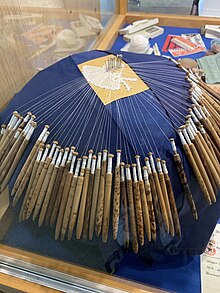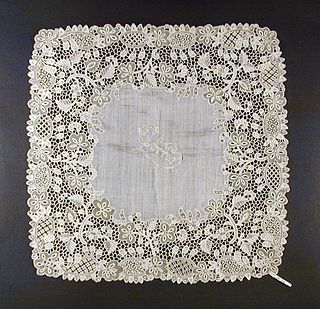


Honiton lace is a type of bobbin lace made in Honiton, Devon, in the United Kingdom. Historical Honiton lace designs focused on scrollwork and depictions of natural objects such as flowers and leaves.



Honiton lace is a type of bobbin lace made in Honiton, Devon, in the United Kingdom. Historical Honiton lace designs focused on scrollwork and depictions of natural objects such as flowers and leaves.
Honiton lace is a part lace. Its ornate motifs and complex patterns are created separately, before being sewn into a net ground. [1] Common motifs include daisies, roses, shamrocks, ivy leaves, butterflies, lilies, camellias, convolvulus, poppies, briony, antwerp diamonds, trefoils, ferns, and acorns. [2]
The art of making lace is rumored to have been brought to Honiton, England by Flemish refugees in the mid-to-late 16th century. [3] An old tombstone in the town is inscribed with information about one James Rodge who is described as a "bone lace seller" who died in 1617; it is not known whether he emigrated from Flanders or not. [4]
In the early period (approx. 1620–1800), sprigs of various designs were worked separately from the net ground by hand, then put together near the end of production. Later (approx. 1800–1840), handmade Honiton lace became obsolete in light of the invention of machine-made net, which was much cheaper to produce. [5] Historian Emily Jackson describes the design changes fostered by the convenience of this approach:
"There was a curious wave of careless designing and inartistic method during the time of this depression, and ugly patterns show 'turkey tails,' 'frying pans,' and hearts. Not a leaf, nor a flower, was copied from nature." [1]
Handmade lacework had a resurgence in popularity in the 19th century when Queen Victoria ordered a Honiton lace bridal dress. The revival happened so quickly, and demand was so great, that a cheaper-quality lace was produced in large quantities. Due to the massive demand, this cheaper work had simpler designs due to the necessary speed of production. Defining designs of lace at this time were "leaves, flowers, [and] scrolls ... [that] look as natural as possible." [5]
19th century Honiton lace incorporates a variety of stitches, including: whole stitch, stem stitch, lace stitch, fibre stitch, long plaitings, square plaitings, broad/cucumber plaitings, Honiton ground, star ground, Dame Joan ground, buckle stitch, Flemish stitch, turn-stitch, chequer stitch, fibre stitch, and Antwerp diamond stitch. [2]

Lace is a delicate fabric made of yarn or thread in an open weblike pattern, made by machine or by hand. Generally, lace is split into two main categories, needlelace and bobbin lace, although there are other types of lace, such as knitted or crocheted lace. Other laces such as these are considered as a category of their specific craft. Knitted lace, therefore, is an example of knitting. This article considers both needle lace and bobbin lace.

Bobbin lace is a lace textile made by braiding and twisting lengths of thread, which are wound on bobbins to manage them. As the work progresses, the weaving is held in place with pins set in a lace pillow, the placement of the pins usually determined by a pattern or pricking pinned on the pillow.

A shawl is a simple item of clothing, loosely worn over the shoulders, upper body and arms, and sometimes also over the head. It is usually a rectangular piece of cloth, but can also be square or triangular in shape. Other shapes include oblong shawls. It is associated with the inhabitants of the northern Indian subcontinent—particularly Kashmir and Punjab—and Central Asia, but can be found in many other parts of the world.

Chantilly lace is a handmade bobbin lace named after the city of Chantilly, France, in a tradition dating from the 17th century. The famous silk laces were introduced in the 18th century. Chantilly lace, was also produced in the 19th century but this one was actually made not in Chantilly area but in the French Norman town Bayeux and in Geraardsbergen, now in Belgium.

Filet lace is the general word used for all the different techniques of embroidery on knotted net. It is a hand made needlework created by weaving or embroidery using a long blunt needle and a thread on a ground of knotted net lace or filet work made of square or diagonal meshes of the same sizes or of different sizes. Lacis uses the same technique but is made on a ground of leno or small canvas, and the style known as Buratto is similarly on woven and not knotted foundations.

Tønder lace is a point-ground type of handmade bobbin lace identified with the Tønder region of Denmark since about 1850, although lace of many types has been made there since as early as 1650. The term is also used more broadly, to refer to any bobbin lace made in Denmark.

Youghal lace is a needle lace inspired by Italian needle lace and developed in Youghal, County Cork, Ireland.

Antwerp lace is a bobbin lace distinguished by stylized flower pot motifs on a six point star ground. It originated in Antwerp, where in the 17th century an estimated 50% of the population of Antwerp was involved in lace making. Antwerp lace is also known, from its familiar repeated motif, as Pot Lace— in Dutch Pottenkant or Potten Kant. It is sometimes said that the flowers were a depiction of the Annunciation lilies; however, the flowers were not limited to lilies.

Valenciennes lace is a type of bobbin lace which originated in Valenciennes, in the Nord département of France, and flourished from about 1705 to 1780. Later production moved to Belgium, in and around Ypres. The industry continued onto the 19th century on a diminished scale. By the 19th century Valenciennes lace could be made by machine.

Mechlin lace or Point de Malines is an old bobbin lace, one of the best known Flemish laces, originally produced in Mechelen. Worn primarily during summer, it is fine, transparent, and looks best when worn over another color. Used for women's clothing, it was popular until the first decade of the 20th century. It was made in Mechelen, Antwerp, Lier and Turnhout. It was used for coiffures de nuit, garnitures de corset, ruffles and cravats.

Brussels lace is a type of pillow lace that originated in and around Brussels. The term "Brussels lace" has been broadly used for any lace from Brussels; however, strictly interpreted, the term refers to bobbin lace, in which the pattern is made first, and the ground, or réseau added, also using bobbin lace. Brussels lace is not to be confused with Brussels point, which is a type of needle lace, though sometimes also called "Brussels lace".

Torchon lace is a bobbin lace that was made all over Europe. It is continuous, with the pattern made at the same time as the ground. Typical basic stitches include whole stitch, half stitch, and twists, and common motifs include spiders and fans. Torchon lace was notable historically for being coarse and strong, as well as consisting of simple geometric patterns and straight lines. It did not use representational designs, for the most part.

Bedfordshire lace is a style of bobbin lace originating from Bedfordshire in the 19th century, and made in the English Midlands lacemaking area. It was worked as a continuous width on a bolster pillow. It is a guipure style of lace.

Lace machines took over the commercial manufacture of lace during the nineteenth century.

Part lace or sectional lace is a way of making bobbin lace. It characterises various styles, such as Honiton lace or Brussels lace.

Mesh grounded lace is a continuous bobbin lace also known as straight lace. Continuous bobbin lace is made in one piece on a lace pillow. The threads of the ground enter motifs, then leave to join the ground again further down the process, all made in one go. This is different from part lace, where the motifs are created separately, then joined together afterwards.
Bobbin lace ground is the regular small mesh filling the open spaces of continuous bobbin lace. Other names for bobbin lace ground are net or réseau. The precise course of the threads and the resultant shape of the ground are an important diagnostic feature in lace identification, as different lace styles use different grounds.

The term Hedebo embroidery covers several forms of white embroidery which originated in the Hedebo (heathland) region of Zealand, Denmark, in the 1760s. The varied techniques which evolved over the next hundred years in the farming community were subsequently developed by the middle classes until around 1820. They were applied to articles of clothing such as collars and cuffs but were also used to decorate bed linen.

Herbert Niebling was a master designer of the style of lace knitting called Kunststricken (art-knitting). Today, his designs remain popular with lace knitting enthusiasts.

Manus x Machina: Fashion in an Age of Technology was an exhibition at the Metropolitan Museum of Art that showcased the dichotomy between Manus, also known as haute couture, and Machina, also known as prêt-à-porter. The Metropolitan Museum of Art debuted this exhibition during the 2016 Met Gala and ran it from May 5, 2016 to September 5, 2016. It included over 120 pieces from designers like Chanel and Christian Dior, varying from the 20th Century to present day.
The Honiton Lace Book: being The Second and Enlarged Edition of Honiton Lace-Making; and Containing Full and Practical Instructions for Acquiring the Art of Making this Beautiful and Fashionable Lace. By "Devonia". 1875.